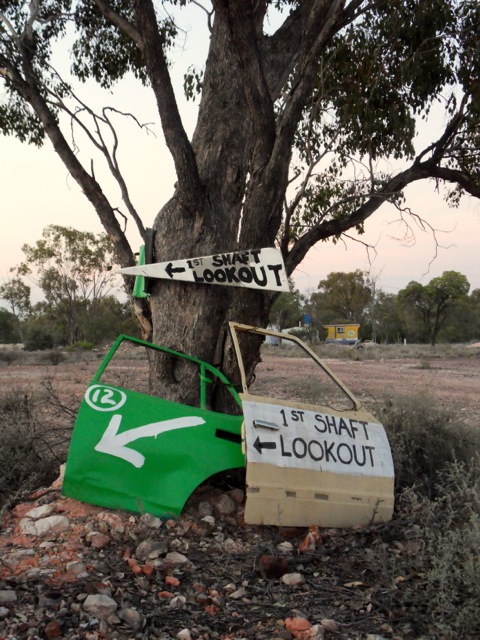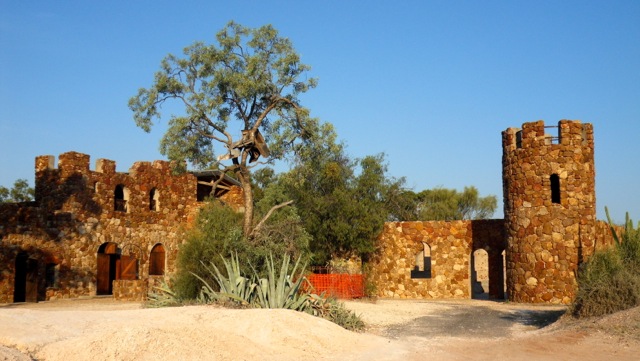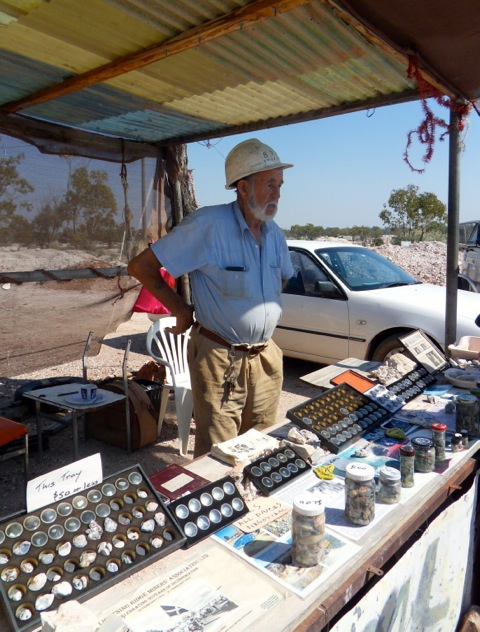Australian Festival of Travel Writing’s 2013 winner of ‘Best Australian Story’ is by Sydney based writer, Marian McGuinness.
Many thanks to all the other writers who sent in their stories. The selection process wasn’t easy. Obviously, there are lots of budding writers out there seeking a voice in a crowded publishing world. Good luck to all of you but only one winner is allowed in this contest and Marian’s story topped the short list.
We like Marian’s story most for its warmly heart-felt sense of place. Using accurate descriptions and colourful phrasing, she captures Lightning Ridge during her short visit.
All the images in this story are also Marian’s.
NHT hopes you like Marian’s story about this eccentric outback town as much as we do.
Opal Odyssey
Lightning Ridge, NSW
by Marian McGuinness
It’s been a long, hot nine-hour drive from Sydney. The colonial towns we’ve passed through could have come straight out of a C.J. Dennis poem. The car tyres beat out the rhythm of Gilgandra, Gulargambone and Coonamble along bitumen and gravel as we race families of emus, part seas of flocking galahs and stop in our tracks for slithering red-bellied black snakes.
We’ve passed golden canola fields and horizons of cotton plantations and we’ve stopped and chatted with a 10-year-old girl droving cattle along the red-rutted road. Her father is kilometres behind, bringing up the rear. We’re in the outback. Things are different.
At dusk, the landscape changes. The silver scrub whooshes by camouflaging the grey kangaroos that make a break in front of our car as they play their game of hit and miss. It’s hard to see them as our windscreen is fractured like stained glass, with baked-on-bugs.
After almost 800 kilometres we arrive in opal country. Black opal. Prized and rare. It is the only stone that has the colour of every other gemstone in it.
The landscape belies the beauty found beneath. It’s kind of post-apocalyptic. Mad-Max meets Russell Drysdale’s earthy canvases of abandonment.
The sign welcomes us. LIGHTNING RIDGE Population?
The first thing we come to is the Artesian Bore Bath, a large round pool in the middle of the grey, stony earth blobbed with weeds and other dabs of desert greenery.
It’s like a scene out of the 80s movie, Cocoon. A few local miners are soaking in the 42-degree mineral rich water that’s spent the last two million years underground. I chat to them while I stretch my legs. They’re wrinkly and weathered and animated. Even with their broken English it’s obvious they were bitten by the opal bug a lifetime ago.
We’re on first name terms only, no surnames are offered. I ask about the sign with the question mark and they tell me it’s because nobody knows how many people are down the shafts. The census doesn’t help, as most don’t fill it in, “there are people out here who don’t want to be found.”
The town earned its name in the 1870s when a drover and his sheep were sheltering from a fierce electrical storm. The lightning struck the ironstone ridge killing the drover, his dog and his 600 sheep.
Straight away I feel a connection to this outback place. It’s ethereal and enigmatic. I don’t know what I’m going to find. The Dreamtime story adds to the magic. The opals are found here because of a huge fire wheel that fell to earth. As it spiralled, it sprayed the land with brilliantly coloured stones.
Having been to the mostly underground opal town of Coober Pedy in South Australia, I’m surprised when driving through The Ridge to find so much activity above ground. Apart from the petrol station (where I’m propositioned by a toned and tanned bushie to come out to the diggings and see his shaft), there’s an IGA supermarket, cafes, pubs, art galleries and even a desert-version of an Olympic pool theme park.
After spending the night in comfortable and spotless self-contained holiday cabins at Chasin’ Opal, my friends and I are ready to explore.
Driving through the moonscape there are miners’ mullock heaps, rusty-tin covered mineshafts and mineral claims marked by regulation metre-high steel pickets and barbed wire. Rusty buckets dangle from crudely made windlasses.
It’s wise to follow the local etiquette. When you see a mullock heap, don’t noodle it, as the miner still has to fossick it to find his pay dirt. There are ‘No Specking – Keep Off ’ signs studding the claims that bristle with grasses and tumbleweeds.
Concrete mixers litter the landscape like art installations. They’ve been modified to agitate and separate the clay from the opal. In The Ridge, nothing is wasted. Lean-tos and huts have sprouted out of cans, bottles, tin and rock.
At the Visitors Information Centre we pick up a brochure about the self-drive Car Door Tours. It’s a quirky enterprise for tourists to see the local sights and a unique way to recycle car doors.
There are four itineraries, each one following a series of painted and numbered doors. There’s the red, blue, green and yellow tour. Each one takes around 30 minutes, but by the time you get out of your car and have a look around, it’s best to leave an hour for each tour.
One of the eccentricities on the Car Door Tours is Amigo’s Castle. Amigo was inspired by the Roman ruins near his home in northern Italy. After digging for opals, his luck never came, but with the ironstone extracted from his mining tunnels, rather than live in a camp he built his own castle, complete with turrets, trapdoors and a dungeon.
The Astronomers’ Monument is another curiosity. Built as a tribute to the Polish astronomer Copernicus, fellow Pole and miner Alex Szperlak, used concrete in various bucket sizes to form the pillars. He then inscribed every surface with references to astronomy.
At Lunatic Hill we meet Brian. He’s in his 80s with eyes as bright as the opal he mines. “I’ve been 43 years in the game and too old to change.” He spins the yarn of how in 1911 some men went to mine the hill. “Whoever goes up there to mine’s a lunatic!” he mimics the codgers of old. “After seven weeks they got opal; helmets full of orange and green stone!” Brian’s told the story thousands of times, but he still laughs with delight, “when you get opal, there’s a hell of a lot of it.”
Tall tales and true tales, take your pick, there are plenty. There’s Harold Hodges, who had his false teeth made out of opals. After years of being asked to smile, Hodges put his colourful choppers on display for all to see at his local pub, by cementing them into the wall.
There are stories of the ratters of the 1900s. Like their namesakes, if these guys were found down other miners’ shafts they were tarred and feathered and run out of town. Just like in the Wild West.
Then there’s laconic John from the cactus farm. While checking out his cut opals, I remarked on how easy it would be to get rid of a body down one of the thousands of mine shafts. Not so, he replied, knowingly, “If you wanna make someone vanish, it’s easier to feed them to the wild pigs.” With that Hitchcock moment we left the prickly cacti and headed to another part of The Ridge, to the Indiana Jones sounding Chambers of the Black Hand.
Eighty steps down into the cool, damp 100-year-old mineshaft and we’re given the rundown on finding opal. Veteran miner, Don, explains that, unlike Coober Pedy, nobody lives underground here. It’s too moist. Bad for arthritis and besides, everything rusts. Not everybody strikes it rich. “I extracted a tennis court a meter and a half deep and ended up with colour in the palm of my hand. Two months’ work!”
As well as checking out the opal-bearing drives (tunnels), the other fascination is that for the last 14 years, miner, Ron Canlin has sculptured an underground art gallery using only a butter knife and spoon.
He’s chiseled an Egyptian chamber complete with a sarcophagus, hieroglyphics and Nefertiti. There’s The Last Supper, Nostradamus, the Terracotta Warriors, samurais and a huge Buddha. For the children, there’s a jungle room filled with African animals, and a plethora of Super Heroes. Canlin has even sculptured his own version of Mount Rushmore, but with Aussie Prime Ministers.
Back above ground we check out John Murray’s art gallery in Opal Street. His paintings capture life in the bush in all its quirks. His lightning storms are unique and his wit sparkles on canvas as he depicts the similarities of human and animal situations. You can see why his art hangs in many of the biggest boardrooms in Australia.
At sunset we head to the outskirts of town, to the original sandstone-capped mining area called Nettleton’s First Shaft. The landscape softens from rusty orange to watermelon pink. It’s crunch-dry beneath my shoes as I fossick in the clay and trace, hoping to turn over a bit of colour.
I’m walking on the sea floor of 120 million years ago, where toothy marine monsters sank in their death that ironically became their future. Opalised bones, flippers and teeth are being found daily, and Lightning Ridge has become a hot new playground for paleontologists, but I’m not destined to be a player. My reward is esoteric.
The whirr of miners’ wind turbines catches the dusk breeze. Distant birdsong stipples the sough of wind down the myriad mine shafts left uncovered by rusty sheets of tin. We gather in a kind of prayerful reverence with other tourists on the edge of the ridge and raise our wine-filled glasses to the west, to the centre of our continent until the sun flames like liquid opal and melts into the horizon.
Naked Facts:
For more information about Lightning Ridge, including accommodation options, tours and festivals, see: www.lightningridgeinfo.com.au or www.visitnsw.com






